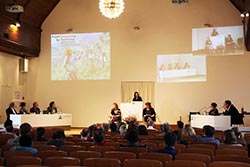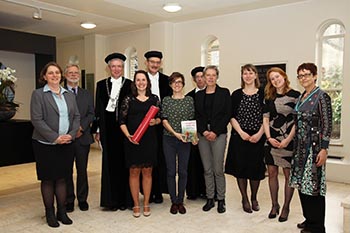| On the 4th of April I successfully defended my PhD thesis, entitled From targeting to tailoring: Baskets of options for legume cultivation among African smallholders, in the aula of Wageningen University. It was a day with interesting discussions and a great celebration afterwards. Unfortunately, co-promotor Peter Ebanyat, who played an important role during the times of my fieldwork in Uganda, could not attend the ceremony at the last minute. |

|
 |
On the photo from lefet to right: Helena Posthumus, Jim Sumberg (Examiners), Marcel Zwietering (Deputy rector), Esther Ronner, Ken Giller (Promotor), Katrien Descheemaeker (Copromotor), Thom Kuyper (Examiner), Conny Almekinders (Coporomotor), Renske Hijbeek, Ilse de Jager (Paranymphs), Bettina Haussmann (Examiner). Missing in the picture is co-promotor Peter Ebanyat who, unfortunately, could not join the ceremony. Photo credit: Sara Kemper Fotografie |
The aim of my thesis was to identify niches for sustainable intensification of agriculture through legumes for different types of smallholder farmers in sub-Saharan Africa. In my thesis, I looked at two legumes: soyabeans in Nigeria and climbing beans in Uganda. In on-farm try-outs of soyabean in Nigeria (Chapter 2) we observed a strong variability in grain yield and response to treatments. Averages of on-farm performance of technologies proved of little value to estimate the benefits of a technology for individual farmers. Although we explained a reasonable percentage of the observed variability in soyabean yield, the potential to use this information to predict the performance of technologies or to target technologies to a new group of farmers remained limited.
Yet, even if we understand where legume technologies work best, this does not necessarily lead to adoption of these technologies. Participatory methods applied in the co-design (i.e. technology development with farmers, researchers and other stakeholders) of improved climbing bean production practices in Uganda (Chapter 3) showed that farmers use a wider range of criteria for the evaluation of legume technologies than yield only. The co-design process resulted in a basket of options for climbing bean cultivation that included alternative options for farmers with varying production objectives, resource constraints and in different agro-ecologies. The options developed through intensive interactions with a small group of users could be used as a starting point for out-scaling to new regions through the application of an ‘option-by-context’ matrix developed as part of the study.
Monitoring of farmers’ use and adaptation of the co-designed options on their own fields over multiple seasons (Chapter 4) revealed that the large majority of farmers did not use the combination of practices that would lead to the largest yield, but adapted the climbing bean technology. Again, we observed variability in grain yields on farmers’ fields and in farmers’ use of practices. Further, we found that the use of practices was inconsistent between years, which complicated the formulation of recommendations about the suitability of technologies for different types of farmers. An ex-ante assessment of the farm-level effects of climbing bean cultivation (Chapter 5) demonstrated that although climbing beans improved food self-sufficiency and income, they often required increased investment and always demanded more labour than current farm configurations. Combined with a discussion with farmers, these findings improved our understanding of farm-level opportunities and constraints for the adoption of climbing beans and helped to explain why certain choices that seem obvious at field level, may work out differently at the farm level.
Throughout my thesis work I was confronted with variability in yields and use of practices, and with inconsistencies in explanatory relationships. This complicated the identification of recommendations about the suitability of technologies for different types of farmers. I therefore considered a basket of options, tailored to local conditions, to be a more useful concept than narrowly specified technology packages for pre-defined farm types. Only recommendation domains at the regional level were considered to have predictive value for targeting of technologies. The inclusion of users’ perspectives in technology development improved the relevance of technologies, but there is an inevitable trade-off between the level of detail and the time invested in obtaining these perspectives. The incorporation of farmers’ evaluations of demonstration trials and their feedback on testing technologies on their own field in technology re-design are two components of this study that are relatively easy to apply in other large-scale research-for-development projects. I found only limited options to improve the benefits of legume technologies for poorer farmers. Agricultural innovations therefore need to go hand in hand with institutional innovation (e.g. through public-private partnerships) to truly impact the livelihoods of poor farmers.
For more information, please contact me at: esther.ronner@wur.nl.
Esther Ronner, Wageningen University & Research
